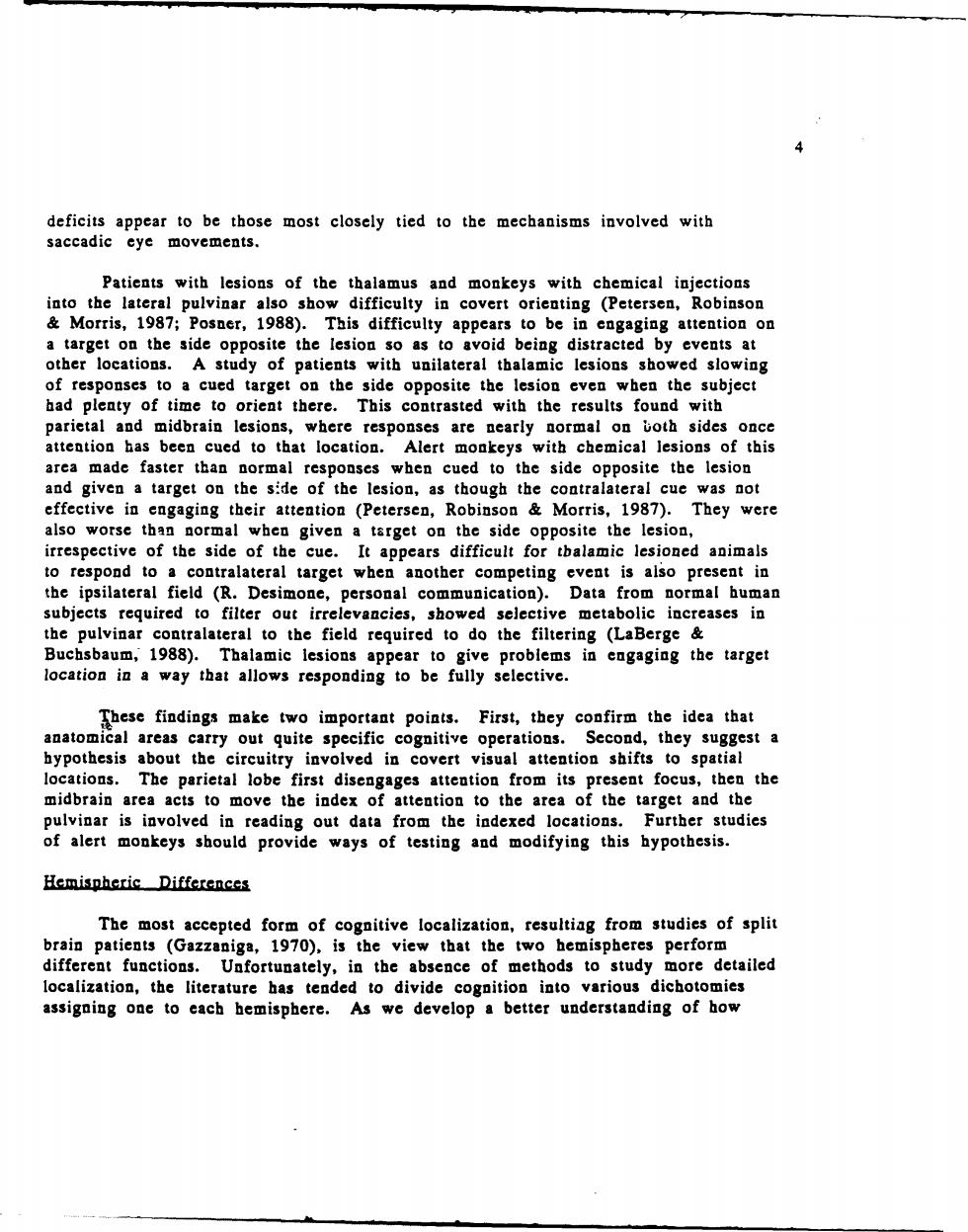正在加载图片...

deficits appear to be those most closely tied to the mechanisms involved with saccadic eye movements. Patients with lesions of the thalamus and monkeys with chemical injections into the lateral pulvinar also show difficulty in covert orienting (Petersen,Robinson Morris,1987;Posner,1988).This difficulty appears to be in engaging attention on a target on the side opposite the lesion so as to avoid being distracted by events at other locations.A study of patients with unilateral thalamic lesions showed slowing of responses to a cued target on the side opposite the lesion even when the subject had plenty of time to orient there.This contrasted with the results found with parietal and midbrain lesions,where responses are nearly normal on both sides once attention has been cued to that location.Alert monkeys with chemical lesions of this area made faster than normal responses when cued to the side opposite the lesion and given a target on the side of the lesion,as though the contralateral cue was not effective in engaging their attention (Petersen,Robinson Morris,1987).They were also worse than normal when given a tsrget on the side opposite the lesion, irrespective of the side of the cue.It appears difficult for tbalamic lesioned animals to respond to a contralateral target when another competing event is also present in the ipsilateral field (R.Desimone,personal communication).Data from normal buman subjects required to filter out irrelevancies,showed selective metabolic increases in the pulvinar contralateral to the field required to do the filtering (LaBerge Buchsbaum,1988). Thalamic lesions appear to give probiems in engaging the target location in a way that allows responding to be fully selective. First,they confirm the idea that areas ca sis rry out quite speci cognitive operations try ved in covert attention shifts to spat midb The parietal lobe first 03, the the move the index of attentio the the targe and ar is lnvolve out data studies ler monkeys should provide ways of testing and modifying this The most accepted fo diffe 8a, 9 ately etailed 100 re to div we develop a aee erst nding of how4 deficits appear to be those most closely tied to the mechanisms involved with saccadic eye movements. Patients with lesions of the thalamus and monkeys with chemical injections into the lateral pulvinar also show difficulty in covert orienting (Petersen, Robinson & Morris, 1987; Posner, 1988). This difficulty appears to be in engaging attention on a target on the side opposite the lesion so as to avoid being distracted by events at other locations. A study of patients with unilateral thalamic lesions showed slowing of responses to a cued target on the side opposite the lesion even when the subject had plenty of time to orient there. This contrasted with the results found with parietal and midbrain lesions, where responses are nearly normal on both sides once attention has been cued to that location. Alert monkeys with chemical lesions of this area made faster than normal responses when cued to the side opposite the lesion and given a target on the s:de of the lesion, as though the contralateral cue was not effective in engaging their attention (Petersen, Robinson & Morris, 1987). They were also worse than normal when given a target on the side opposite the lesion, irrespective of the side of the cue. It appears difficult for tbalamic lesioned animals to respond to a contralateral target when another competing event is also present in the ipsilateral field (R. Desimone, personal communication). Data from normal human subjects required to filter out irrelevancies, showed selective metabolic increases in the pulvinar contralateral to the field required to do the filtering (LaBerge & Buchsbaum. 1988). Thalamic lesions appear to give problems in engaging the target location in a way that allows responding to be fully selective. These findings make two important points. First, they confirm the idea that anatomical areas carry out quite specific cognitive operations. Second, they suggest a hypothesis about the circuitry involved in covert visual attention shifts to spatial locations. The parietal lobe first disengages attention from its present focus, then the midbrain area acts to move the index of attention to the area of the target and the pulvinar is involved in reading out data from the indexed locations. Further studies of alert monkeys should provide ways of testing and modifying this hypothesis. Hemispheric Differences The most accepted form of cognitive localization, resultiag from studies of split brain patients (Gazzaniga, 1970), is the view that the two hemispheres perform different functions. Unfortunately, in the absence of methods to study more detailed localization, the literature has tended to divide cognition into various dichotomies assigning one to each hemisphere. As we develop a better understanding of how